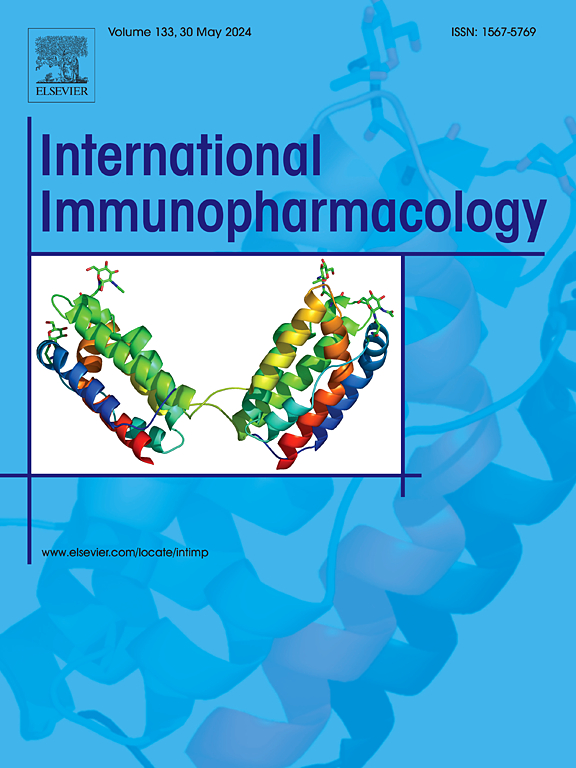退伍军人硫芥毒性与氧化/抗氧化系统的关系:病例对照研究的荟萃分析。
IF 4.8
2区 医学
Q2 IMMUNOLOGY
引用次数: 0
摘要
硫芥(SM)是一种化学战剂,可以增加退伍军人的氧化应激。评估sm暴露退伍军人的氧化/抗氧化参数的文献包含相互矛盾的结果。共确定并筛选了11项相关研究。提取数据,评估效应大小和异质性。分析显示,SM暴露后丙二醛(MDA,脂质过氧化指标)、过氧化氢酶(CAT)水平显著升高,谷胱甘肽(GSH)水平降低,而超氧化物歧化酶(SOD)和总抗氧化剂水平没有变化。荟萃分析显示,除gsh水平仅在21-33年暴露后采样时间下降外,MDA和CAT水平在15-20年和21-33年两个暴露后采样时间均显著升高。分析样品类型的亚组荟萃分析显示,血清/血浆样品中SOD和CAT水平升高,而GSH水平降低。BALF/痰和红细胞样品显示MDA和SOD水平显著升高,GSH水平显著降低。这项荟萃分析得出结论,SM暴露会影响氧化剂和抗氧化剂之间的平衡,促进可能在暴露后长期存在的氧化应激。这种情况强调需要采取策略来增强sm暴露退伍军人的抗氧化防御。本文章由计算机程序翻译,如有差异,请以英文原文为准。

Association of sulfur mustard toxicity with oxidant/antioxidant system in veterans: A meta-analysis of case-control studies
Sulfur mustard (SM) is a chemical warfare agent that increases oxidative stress in veterans. The literature assessing oxidant/antioxidant parameters in SM-exposed veterans contains conflicting results. A total of 11 relevant studies were identified and screened. Data were extracted, and effect size and heterogeneity were assessed. The analysis revealed significant elevations in levels of malondialdehyde (MDA, an indicator of lipid peroxidation), catalase (CAT), and a reduction in glutathione (GSH) following SM exposure while superoxide dismutase (SOD) and total antioxidant levels did not change. The meta-analysis revealed that the MDA and CAT levels significantly increased in the two post-exposure sampling times (15–20 and 21–33 years) except for the GSH level, which decreased only in the post-exposure sampling time of 21–33 years. The subgroup meta-analysis of the type of analyzed samples indicated that SOD and CAT levels were only increased in the serum/plasma samples, while GSH was decreased. BALF/sputum and erythrocyte samples also revealed significant increases in MDA and SOD levels while GSH level was significantly decreased. This meta-analysis concluded that SM exposure affects the balance between oxidants and antioxidants, promoting oxidative stress that may persist long after exposure. This condition highlights the need for strategies to enhance antioxidant defenses in SM-exposed veterans.
求助全文
通过发布文献求助,成功后即可免费获取论文全文。
去求助
来源期刊
CiteScore
8.40
自引率
3.60%
发文量
935
审稿时长
53 days
期刊介绍:
International Immunopharmacology is the primary vehicle for the publication of original research papers pertinent to the overlapping areas of immunology, pharmacology, cytokine biology, immunotherapy, immunopathology and immunotoxicology. Review articles that encompass these subjects are also welcome.
The subject material appropriate for submission includes:
• Clinical studies employing immunotherapy of any type including the use of: bacterial and chemical agents; thymic hormones, interferon, lymphokines, etc., in transplantation and diseases such as cancer, immunodeficiency, chronic infection and allergic, inflammatory or autoimmune disorders.
• Studies on the mechanisms of action of these agents for specific parameters of immune competence as well as the overall clinical state.
• Pre-clinical animal studies and in vitro studies on mechanisms of action with immunopotentiators, immunomodulators, immunoadjuvants and other pharmacological agents active on cells participating in immune or allergic responses.
• Pharmacological compounds, microbial products and toxicological agents that affect the lymphoid system, and their mechanisms of action.
• Agents that activate genes or modify transcription and translation within the immune response.
• Substances activated, generated, or released through immunologic or related pathways that are pharmacologically active.
• Production, function and regulation of cytokines and their receptors.
• Classical pharmacological studies on the effects of chemokines and bioactive factors released during immunological reactions.

 求助内容:
求助内容: 应助结果提醒方式:
应助结果提醒方式:


